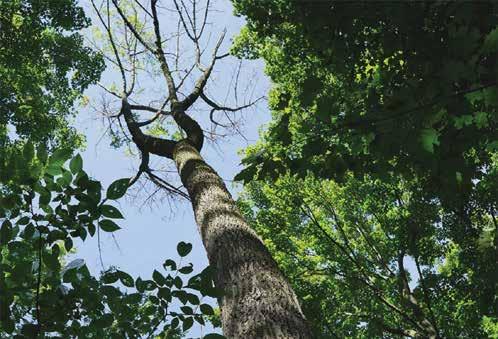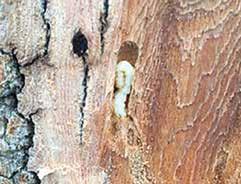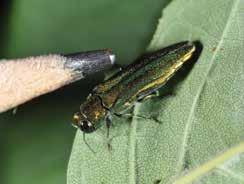
4 minute read
Ash Trees and Tigers and Koala Bears
Environmental Management
Ash Trees and Tigers and Koala Bears. . . Oh My!!
What do ash trees, Cambodian tigers, and koala bears have in common? They are all considered to be functionally extinct in certain parts of the world. By definition, any species can become functionally extinct when the organism no longer exists in numbers that allow it to reproduce.
The tiger population in Cambodia is no longer viable since there are no longer any breeding tigers in the wild. The same thing is happening to Koala bears in Australia in certain regions. In Pennsylvania and elsewhere in this country, ash trees are now dying before they are able to reach maturity and produce offspring. This functional extinction can ultimately lead to local extinction which can then lead to total extinction.
Last summer Garrett Beers from the Pennsylvania DCNR (Department of Conservation and Natural Resources) came to Tanglwood and led a few of us on an educational outing to identify and note the characteristics of ash trees that are unhealthy. He pointed out the dying leaves at the top 1/3 of the trees, the existence of newly sprouted lower side branches (called water sprouts), and the white peeling bark often with the eaten out trails underneath and external woodpecker holes, all characteristics of an ash tree that has been infected with the emerald ash leaf borer. This rather lovely bright metallic green beetle is an invasive critter that uses the ash tree as its nesting site. Once eggs are laid and larvae hatch, the larvae feed on the living cells of the tree directly under the bark. Woodpeckers going after the larvae chip away at the outer protective layer of bark exposing the inner bark. This is why the bark becomes whitish in color and then ultimately falls off of the tree. Once mature, the larvae emerge as beetles and start the life cycle all over again. Since the tree begins to lose its ability to feed its upper branches, those branches lose their leaves. In response to the infestation, and as a last-ditch effort to survive, the tree then starts to push out new branches on the lower part of the tree. This is totally in vain since by then the tree is already doomed. Once a tree is badly infected, nothing can be done to save it.
In Tanglwood many of the ash trees are already infected and many have died. Unlike a dead-standing oak that can remain tall and strong for 50 years or more, a dead ash tree, due to its weaker cellular fibers, can usually only stand about 18 months. This makes a dead ash tree much more dangerous because it is apt to fall not long after it dies and cause damage to adjacent trees or property. If you find a dead or dying tree, you might want to have it professionally removed to prevent damage from when it will ultimately fall. Remember if you cut down an ash tree, do not transport any firewood from the tree to a far away location. Doing so might spread the ash borer to a location that is not as yet infected.




The DCNR has many educational opportunities for schools and individual families. There are so many fun family things to do! Check out their Educational Link.
https://www.dcnr.pa.gov/Education/Pages/ default.aspx
Non-infected or minimally infected ash trees can often be saved by insecticidal treatment. Mr. Beers did find a healthy ash tree on one homeowner’s property, and they are now having it treated to try to save it. This might buy the DCNR and other agencies some time in the hopes that a more effective treatment might be found to eradicate the emerald ash borer.
https://wwf.panda.org/projects/ connect2tigers/last_tiger_of_cambodia/
https://wildlifewarriors.org.au/ conservation-projects/koala-con servation?gclid=Cj0KCQiAmKiQB hClARIsAKtSj-me2OCgDT49gv6sBBg4K2nrnZqFIWOYgt6qBsu1j97nM5W_ eX0AoaAm7uEALw_wcB
All images are from Dr. Clifford S. Sadof, Purdue University and Garrett Beers, PA DCNR. If you have questions, the contact information for our Pike County DCNR is Garrett Beers, DCNR 2174A Route 611 Swiftwater, PA 18370 Phone: 570-656-6675 garbeers@pa.gov


Meanwhile there are many things property owners can do to try and help. Learning how to identify ash trees is critical since if you find a healthy one, you might opt for New Yoga & Meditation Studio a chemical treatment to try to save it. Please see our website for classes and scheduling
www.alternativecurenepa.com
1007 Main Street, Newfoundland PA (570) 390-0120







